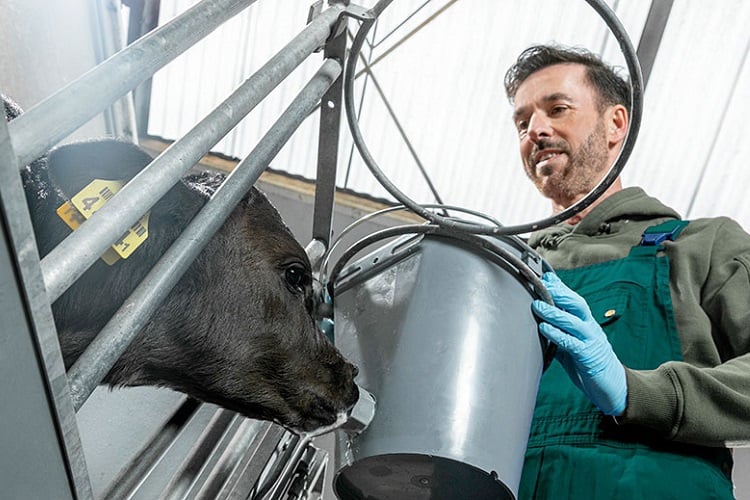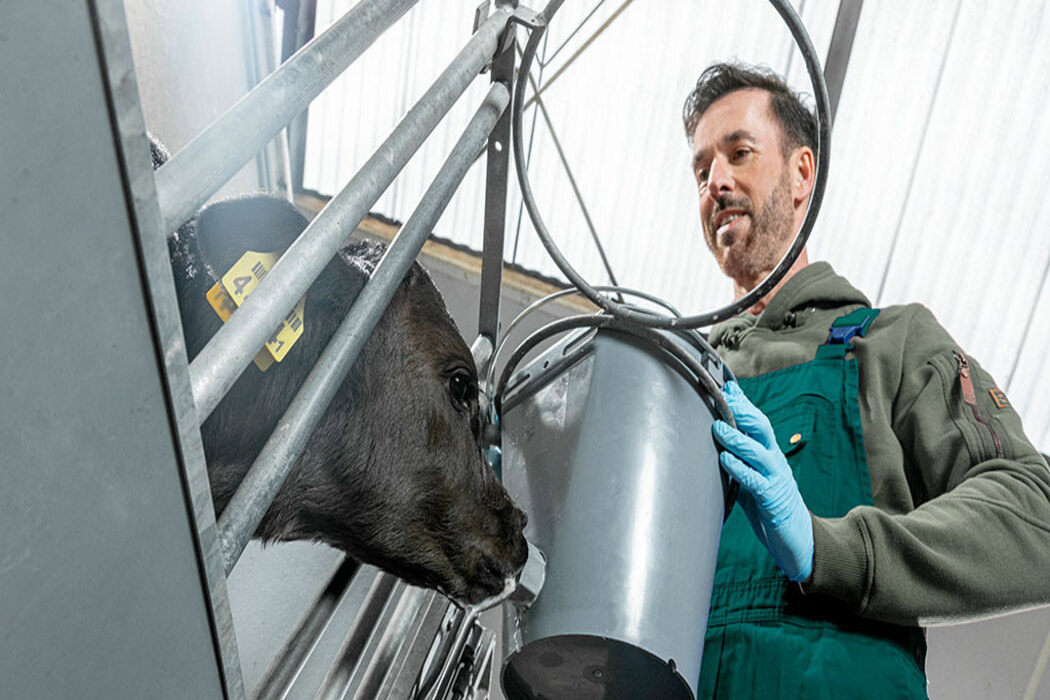
- LifeStart
- Glucose metabolism
- Lifestart themes
Key takeaways from the research
-
To mimic the composition of whole milk lactose in calf milk replacers can be partially replaced with fat
-
Partially replacing lactose with fat benefits growth and has a minimal impact on glucose homeostasis

Partially replacing lactose with fat improves growth while having a minimal impact on glucose homeostasis
Dairy calf research has focused on feeding elevated planes of milk or calf milk replacer (CMR) to improve preweaning growth and performance[1,2]. This practice is often implemented without considering the dietary macronutrient composition of the liquid feed. Relative to whole milk, CMR generally contains more lactose and less fat [3,4,5]. This is a consequence of economic restrictions that drive formulations with higher levels of protein and fat[6] and the use of lactose rich by-products from cheese manufacturing. It was previously thought that this approach would minimize body fat deposition in growing Holstein heifers [7].
It is thought that excess available glucose from high-lactose CMR will decrease insulin sensitivity and that a high-lactose CMR will result in faster abomasal emptying. Welboren et al evaluated how partially replacing lactose in CMR formulations with fat affect glucose-insulin kinetics during an insulin-modified intravenous glucose tolerance test (IM-IVGTT) and postprandial sampling in calves during their first week of life.
Study design
Two groups of 17 calves each were enrolled immediately at birth to focus on the first weeks of life, during which calves transition from colostrum to milk and undergo major metabolic adaptations. Calves were blocked by dam parity and randomly assigned to either a high lactose MR (HL) or high fat MR (HF). The assigned MR was fed 24h after birth once colostrum feeding was complete. MR was fed at 150g/litre and bottle-fed at 18.1% of bodyweight. Intake and refusals were recorded for each meal. Fresh, clean water was available ad libitum and intakes were recorded.
On day 4 a glucose tolerance test was completed 8h after the morning meal. Postprandial abomasal emptying and plasma glucose and insulin curves were determined on day 6. The pancreas and liver were collected and weighed on day 7, with subsamples being collected and processed onto glass slides for image capture.
Results and conclusion
The results of this study demonstrate that partially replacing lactose in CMR formulation with fat increased BW gain as well as gain intake in neonatal dairy calves during the first week of life. Furthermore, feeding a high-fat MR slowed abomasal emptying and reduced postprandial glucose and insulin concentrations.
References
[1] MacPherson, J. A. R., H. Berends, L. N. Leal, J. P. Cant, J. Martin-Tereso, and M. A. Steele. 2016. Effect of plane of milk replacer intake and age on glucose and insulin kinetics and abomasal emptying in female Holstein Friesian dairy calves fed twice daily. J.Dairy Sci. 99:8007–8017
[2] Khan, M. A., D. M. Weary, and M. A. G. Von Keyserlingk. 2011. Invited review: Effects of milk ration on solid feed intake, weaning, and performance in dairy heifers. J. Dairy Sci. 94:1071–1081.
[3] Lee, H. J., M. A. Khan, W. S. Lee, S. H. Yang, S. B. Kim, K. S. Ki, H. S. Kim, J. K. Ha, and Y. J. Choi. 2009. Influence of equalizing the gross composition of milk replacer to that of whole milk on the performance of Holstein calves. J. Anim. Sci. 87:1129–1137
[4] Pantophlet, A. J., M. S. Gilbert, J. J. van den Borne, W. J. Gerrits, H. Roelofsen, M. G. Priebe, and R. J. Vonk. 2016b. Lactose in milk replacer can partly be replaced by glucose, fructose, or glycerol without affecting insulin sensitivity in veal calves. J. Dairy Sci. 99:3072–3080.
[5] Amado, L., H. Berends, L. N. Leal, J. Wilms, H. Van Laar, W. J. J.Gerrits, and J. Martin-Tereso. 2019. Effect of energy source in calf milk replacer on performance, digestibility, and gut permeability in rearing calves. J. Dairy Sci. 102:3994–4001
[6] Hof, G. 1980. An investigation into the extent to which various dietary components, particularly lactose, are related to the incidence of diarrhoea in milk-fed calves. PhD Diss. Wageningen University, Wageningen, the Netherlands.
[7] Tikofsky, J. N., M. E. Van Amburgh, and D. A. Ross. 2001. Effect of varying carbohydrate and fat content of milk replacer on body composition of Holstein bull calves. J. Anim. Sci. 9:2260–2267






